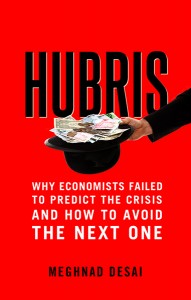The title of Meghnad Desai’s new book, Hubris, had led me to expect a jeremiad about the failings of economics, with a faint feeling of resignation. Not that the charges are (all) undeserved, just that it’s become rather familiar. However, my expectations were confounded. The book is a very accessible and clear history of macroeconomic thought, seen from the perspective of what economists have done over the decades – what ideas, what models they have used. It makes an excellent follow-on companion to Tim Harford’s [amazon_link id=”B00ABLJ6OE” target=”_blank” ]The Undercover Economist Strikes Back[/amazon_link], being a bit less general, and introducing more economic terminology and verbal (largely) descriptions of models.
[amazon_image id=”0300213549″ link=”true” target=”_blank” size=”medium” ]Hubris: Why Economists Failed to Predict the Crisis and How to Avoid the Next One[/amazon_image]
A lot of the material covers territory that will be familiar to professional economists, but it is set in the context of how macroeconomics got itself into the position of being not only unsuccessful at predicting the financial crisis but literally unable to do so. Macro models excluded the logical possibility of sustained and serious disequilibrium. Desai also includes some economists who are not part of the usual story, for reasons that become apparent in the final section of the book. Marx and Hayek of course, but also Kondratiev, Wicksell, Richard Goodwin. (I’d never heard of Goodwin – he provided a mathematical, ecology-inspired model of the wage share.)The book explains how alternative views came to be not even attacked, simply ignored, in modern macro. It includes a section on Keynes and the reinterpretation and reinvention and finally co-opting of ‘Keynes’ over the years
The final section sets out briefly Lord Desai’s own framework for macroeconomics. He sees the evolution of the economy in the aggregate as the outcome of a disequilibrium process, with Kondratiev cycles driven by demography and technology and shorter “class struggle” cycles of changing labour and profit shares superimposed, in the context of a globalised economy. This is clearly more realistic than some of the DSGE macro models that are clinging on to life, albeit less useful for forecasting.
The long wave perspective is quite interesting and plausible. One other point that I wholly agree with is the narrowness of traditional macro models in their nation by nation focus: “National income data began to be estimated and published in a small way in the 1930s. After the war and thanks to the Keynesian revolution, national income measurement became a pivotal tool of policy making … This has shaped the themes and strategies of research in macroeconomics. New classical macroeconomics has been very much concerned with analyzing US time series. … The older tradition had less accurate data but it’s vision was systematically global rather than inter-country.”
The book also, rather gloomily, sees the world as being at the start of a long wave downturn, in for a structural version of secular stagnation, with decades of falling prices ahead. “Could the global economy repeat the 19th century’s experience of the Great Depression of 1873-96.”
I’m not so gloomy but this might be possible. It would anyway make enormous sense for macroeconomists to link their work with growth theory and thinking about innovation, including work on long cycles such as [amazon_link id=”1843763311″ target=”_blank” ]Technological Revolutions and Financial Capital: The Dynamics of Bubbles and Golden Ages[/amazon_link] by Carlotta Perez. Mind you there are lots of things it would be sensible for macroeconomists to do, but the hubris lingers on.

